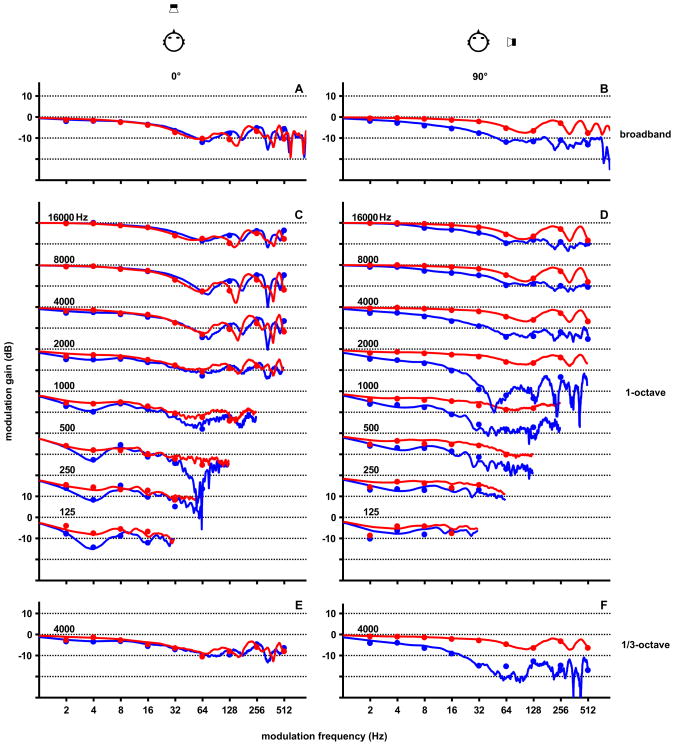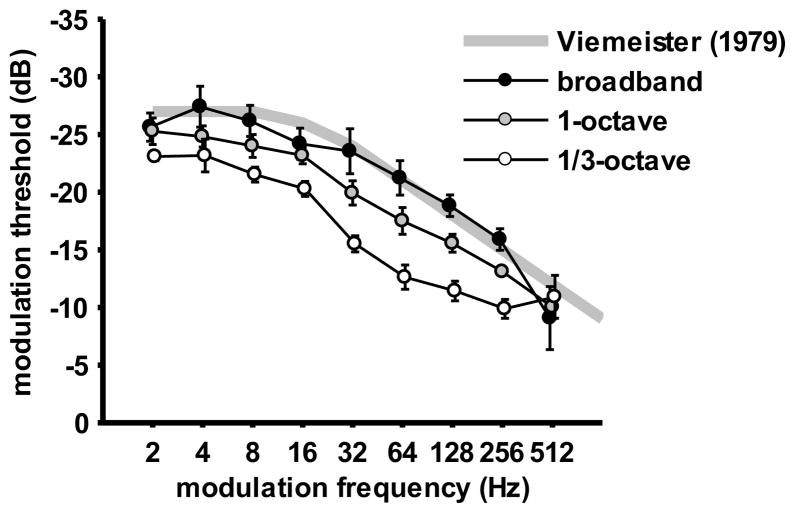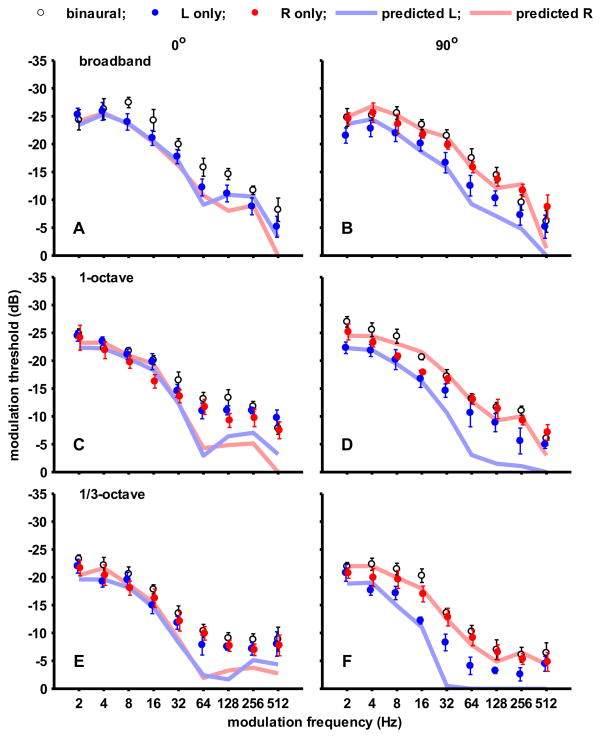Abstract
Previous work [Zahorik et al., POMA, 12, 050005 (2011)] has reported that for a broadband noise carrier signal in a simulated reverberant sound field, human sensitivity to amplitude modulation (AM) is higher than would be predicted based on the broadband acoustical modulation transfer function (MTF) of the listening environment. Interpretation of this result was complicated by the fact that acoustical MTFs of rooms are often quite different for different carrier frequency regions, and listeners may have selectively responded to advantageous carrier frequency regions where the effective acoustic modulation loss due to the room was less than indicated by a broadband acoustic MTF analysis. Here, AM sensitivity testing and acoustic MTF analyses were expanded to include narrowband noise carriers (1-octave and 1/3-octave bands centered at 4 kHz), as well as monaural and binaural listening conditions. Narrowband results were found to be consistent with broadband results: In a reverberant sound field, human AM sensitivity is higher than indicated by the acoustical MTFs. The effect was greatest for modulation frequencies above 32 Hz and was present whether the stimulation was monaural or binaural. These results are suggestive of mechanisms that functionally enhance modulation in reverberant listening.
1. Introduction
Sensitivity to changes in sound’s amplitude envelope over time forms a critical aspect of auditory perception that supports human abilities to identify sources of sound and to understand speech. One approach to quantifying the temporal resolution of the human auditory system involves measurement of detection threshold modulation depth for amplitude modulation (AM) for various modulation frequencies in order to estimate the modulation transfer function (MTF) of the auditory system (Viemeister, 1979). This approach and the knowledge it has generated forms the basis for a standard method of predicting the intelligibility of speech signals: the speech transmission index, or STI (Houtgast and Steeneken, 1985), and has helped to develop processing strategies for cochlear implants that effectively convey speech information through variations in signal envelope (Shannon et al., 1995).
Although it is well-known that various environmental factors, such as room reverberation or background noise, can profoundly influence the AM reaching a listener’s ears (Houtgast and Steeneken, 1985), the influence of room acoustic effects has not been extensively studied under realistic listening conditions. One study by Danilenko (1969) did measure modulation detection (1 – 10 Hz modulation frequency) in a reverberant room, and reported up to 6 dB lower thresholds for binaural versus monaural input. This result suggests that binaural information is used to aid modulation detection in reverberation, and is consistent with other reports of the “binaural squelch” of reverberation (Koenig, 1950). The results are limited, however, because the study was only conducted for a limited range of modulation frequencies and only a single source location.
Previous work (Zahorik et al., 2011) has reported that for a broadband noise carrier signal in a simulated reverberant sound field, human sensitivity to amplitude modulation is 4 – 6 dB lower than would be predicted based on the broadband acoustical MTF of the listening environment. Interpretation of this result was complicated by the fact that acoustical MTFs of rooms are often quite different for different carrier frequency regions, and listeners may have selectively responded to advantageous frequency regions where the effective modulation loss due to the room was less than indicated by a broadband MTF analysis. The purpose of this study is to evaluate the role of carrier bandwidth and binaural presentation on human AM sensitivity in reverberant sound fields.
2. Methods
2.1 Subjects
Five normal-hearing listeners (4 male, 1 female, age range 24 – 42 years) participated in the experiment. All were authors of this study (PZ, PA, EB, RC, NS).
2.2 Sound Field Simulation
Virtual auditory space techniques were used to simulate a sound field in a reverberant room with dimensions of 5.7 × 4.3 × 2.6 m (L × W × H) and a broadband reverberation time, T60, of approximately 1.8 s. Non-individualized head-related impulse responses were used for the simulation, which synthesized binaural room impulse responses (BRIRs) using techniques described by Zahorik (2009). Two source locations were tested at a fixed distance of 1.4 m: directly in front of the listener (0°), and opposite the listener’s right ear (90°). Both monaural and binaural sound field listening conditions were tested, as well as a diotic control condition that contained no BRIR processing.
2.3 Acoustic MTF Determination
Two methods of determining the acoustic MTFs for each sound field listening condition were used. The first method determined the MTF directly by comparing the modulation depth in a sinusiodally modulated Gaussian noise signal (broadband, 1-octave, or 1/3-octave bandwidth) pre- and post-convolution with BRIRs at octave-spaced modulation frequencies ranging from 2 to 512 Hz. The pre-convolution modulation depth was set to 50% for all comparisons. The second method is adapted from a technique described by Schroeder (1981), where the BRIR is first band-pass filtered with a bandwidth of 1 or 1/3 octave and the MTF is computed as the energy, at each frequency, of the squared band-pass filtered impulse response normalized by its total energy. The broadband case is computed identically, but without the bandpass filtering stage.
2.4 Stimuli and Procedure
To facilitate rapid behavioral MTF data collection, a method of adjustment procedure was used in which subjects were instructed to adjust the level of sinusoidal AM so that it was just audible. This method was identical to that used in a previous study (Zahorik et al., 2011). Adjustments were conducted for 9 modulation frequencies from 2 – 512 Hz in octave steps and implemented in real time via MAX/MSP software (Cycling ’74) using the Freeverb3 VST plug-in for BRIR convolution. Three source signals were tested: broadband noise, and narrow band noises with 4 kHz center frequencies and bandwidths of 1 octave and 1/3 octave.
3. Results
Figure 1 displays acoustic MTFs from the simulated reverberant sound field at both 0° and 90° for three different carrier bandwidths: broadband, 1-octave, and 1/3-octave. Consistent with past research, the test room exhibits a low-pass characteristic (Houtgast and Steeneken, 1985). However, its shape varies considerably as a function of frequency, bandwidth, and source direction. Good agreement between the two methods of MTF determinations is observed. These results are qualitatively consistent with acoustic MTFs derived using a similar analysis procedure with actual BRIRs of human subjects in a reverberant room (Kim et al., 2012).
Fig. 1.
Acoustic MTFs for the simulated reverberant sound field used for testing in this study. MTFs are displayed for both source orientations (0° and 90°) and for both left (blue) and right (red) ears at three different carrier signal bandwidths: broadband, 1-octave, and 1/3-octave. For the 1-octave bandwidth, MTFs for center frequencies ranging from 125 to 16000 Hz are shown, offset by 20 dB for display purposes. For the 1/3-octave bandwidth, only the 4000 Hz center frequency is shown. The curves in all panels represent MTFs computed with the squared BRIR method and the symbols represent results of the direct method of MTF determination obtained with a modulation depth of 50% (see text for details).
Behavioral MTF results with diotic stimuli (not filtered with BRIR) are shown in Fig. 2. They provide validation for the method of adjustment procedure and quantify carrier bandwidth effects on the MTF in the absence of a room. Behavioral MTF results for the simulated reverberant room are shown in Fig. 3. Narrow band results were found to be consistent with broadband results: In the reverberant sound field, human AM sensitivity was more sensitive (by as much as 8 dB at certain modulation frequencies) than predicted by the acoustical MTFs. This indicates that the auditory system enhances AM sensitivity by counteracting deleterious effects of reverberation, thereby producing reverberation-resistant AM processing. This enhancement effect was present at modulation frequencies above 32 Hz for both monaural and binaural stimulation. However, binaural advantage can be noticeable; it is larger for a broadband carrier than for narrow band carriers and larger for 0° than for 90° azimuth. This is consistent with previous results obtained with a broadband carrier at 0° azimuth that report a 3 to 6 dB binaural advantage at 8 Hz modulation frequency (Danilenko, 1969). Overall, the observed enhancement effect is consistent with recent neural data that demonstrate the presence of reverberation-resistant coding of AM in the response properties of single neurons in the inferior colliculus (Kuwada et al., 2012).
Fig. 2.
Mean (n = 5) behavioral MTFs for diotic presentation (no BRIR processing). Results for a broadband and two different narrow band noise carriers (centered at 4000 Hz) are shown, as is a stylistic representation of classic data from Viemeister (1979) for a broadband carrier. Bars indicate ±1 standard error of the mean (SEM). Monaural behavioral MTFs (not shown) were very similar to the diotic MTF for each carrier.
Fig. 3.
Mean (n = 5) behavioral MTFs for two source directions (0° straight ahead, and 90° to the listener’s right side) in a simulated reverberant room (distance = 1.4 m) for the same carrier signals and procedures as shown in Fig. 2. Results from both binaural and monaural (left ear only and right ear only) are shown. Bars indicate ±1 SEM. Predicted MTFs for left and right ears are based on the diotic performance for a given carrier (Fig. 2) minus the acoustical MTF gain caused by the room for that carrier (Fig. 1).
4. Conclusions
Human AM sensitivity is resistant to the degradation of modulation caused by reverberation. This resistance can operate either monaurally or binaurally, and is relatively unaffected by carrier bandwidth.
Acknowledgments
Work supported in part by grants from the NIH-NIDCD (R01 DC008168, Zahorik; R01 DC002178, Kuwada).
References and links
- Danilenko L. Binaural hearing in non-stationary diffuse sound field. Kybernetik. 1969;6:50–57. [PubMed] [Google Scholar]
- Houtgast T, Steeneken HJM. A review of the MTF concept in room acoustics and its use for estimating speech intelligibility in auditoria. J Acoust Soc Am. 1985;77:1069–1077. [Google Scholar]
- Kim DO, Kuwada S, Bishop B, Zahorik P. Acoustic modulation transfer functions for human listeners in anechoic and reverberant environments. Assoc Res Otolaryngol Abs. 2012;35:105. [Google Scholar]
- Koenig W. Subjective effects in binaural hearing. J Acoust Soc Am. 1950;22:61–62. [Google Scholar]
- Kuwada S, Zahorik P, Bishop B, Kim DO. What and where processing in the inferior colliculus. Assoc Res Otolaryngol Abs. 2012;35:92. [Google Scholar]
- Schroeder MR. Modulation transfer functions: Definition and measurement. Acustica. 1981;49:179–182. [Google Scholar]
- Shannon RV, Zeng FG, Kamath V, Wygonski J, Ekelid M. Speech recognition with primarily temporal cues. Science. 1995;270:303–304. doi: 10.1126/science.270.5234.303. [DOI] [PubMed] [Google Scholar]
- Viemeister NF. Temporal modulation transfer functions based upon modulation thresholds. J Acoust Soc Am. 1979;66:1364–1380. doi: 10.1121/1.383531. [DOI] [PubMed] [Google Scholar]
- Zahorik P. Perceptually relevant parameters for virtual listening simulation of small room acoustics. J Acoust Soc Am. 2009;126:776–791. doi: 10.1121/1.3167842. [DOI] [PMC free article] [PubMed] [Google Scholar]
- Zahorik P, Kim DO, Kuwada S, Anderson PW, Brandewie E, Srinivasn NK. Amplitude modulation detection by human listeners in sound fields. POMA. 2011;12:050005. doi: 10.1121/1.3656342. [DOI] [PMC free article] [PubMed] [Google Scholar]





